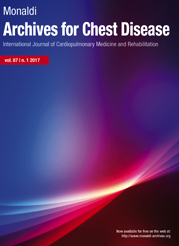Agreement between the one-minute sit-to-stand test and the six-minute walk test in assessing exercise capacity in patients with interstitial lung disease
All claims expressed in this article are solely those of the authors and do not necessarily represent those of their affiliated organizations, or those of the publisher, the editors and the reviewers. Any product that may be evaluated in this article or claim that may be made by its manufacturer is not guaranteed or endorsed by the publisher.
Authors
The six-minute walk test (6-MWT) assesses functional exercise capacity in interstitial lung disease (ILD), providing key prognostic and functional insights. Logistical challenges, such as space and time limitations, limit its clinical use. The one-minute sit-to-stand test (1-MSTST) has emerged as a practical, space- and time-efficient alternative reflecting similar functional capacity. This study examined 1-MSTST and 6-MWT agreement in ILD patients and their correlations with pulmonary function tests and physiological responses. A prospective observational study was conducted on patients diagnosed with ILD at a tertiary care center. Patients underwent both 6-MWT and 1-MSTST at baseline, with follow-ups at 3 and 6 months. The agreement between these two tests was assessed using Lin’s concordance correlation coefficient (CCC). Secondary outcomes included correlations with pulmonary function parameters, such as forced vital capacity (FVC) and diffusion lung capacity for carbon monoxide, and physiological responses, including oxygen desaturation, heart rate variation, blood pressure variation, and perceived exertion measured by the Modified Borg Dyspnea Score. They were assessed using the Spearman correlation coefficient. A total of 59 patients completed the study. At baseline, a moderate agreement between 1-MSTST and 6-MWT was observed (CCC=0.37), which improved over time with CCC values of 0.49 at 3 months and 0.54 at 6 months, indicating increasing concordance. Both tests demonstrated similar oxygen desaturation responses and Borg score variations, highlighting their utility in detecting exercise-induced hypoxemia. While 6-MWT showed significant correlations with FVC (r=0.34, p=0.009) and peak expiratory flow rate (PEFR, r=0.39, p=0.002), 1-MSTST exhibited weaker associations with lung function parameters. The 1-MSTST is a feasible and practical alternative to the 6-MWT for assessing exercise capacity in ILD patients, particularly in resource-limited settings where space and time constraints hinder using the 6-MWT. Its ease of implementation and ability to detect exercise-induced desaturation make it a valuable tool for routine clinical assessment and follow-up of ILD patients.
Ethics Approval
The study protocol was approved by the Ethics committee of the institution of All India Institute of Medical Sciences, Bhubaneswar with document number: (IEC/AIIMS BBSR/PG Thesis/2022-23/98), dated February 13, 2023.How to Cite

This work is licensed under a Creative Commons Attribution-NonCommercial 4.0 International License.






